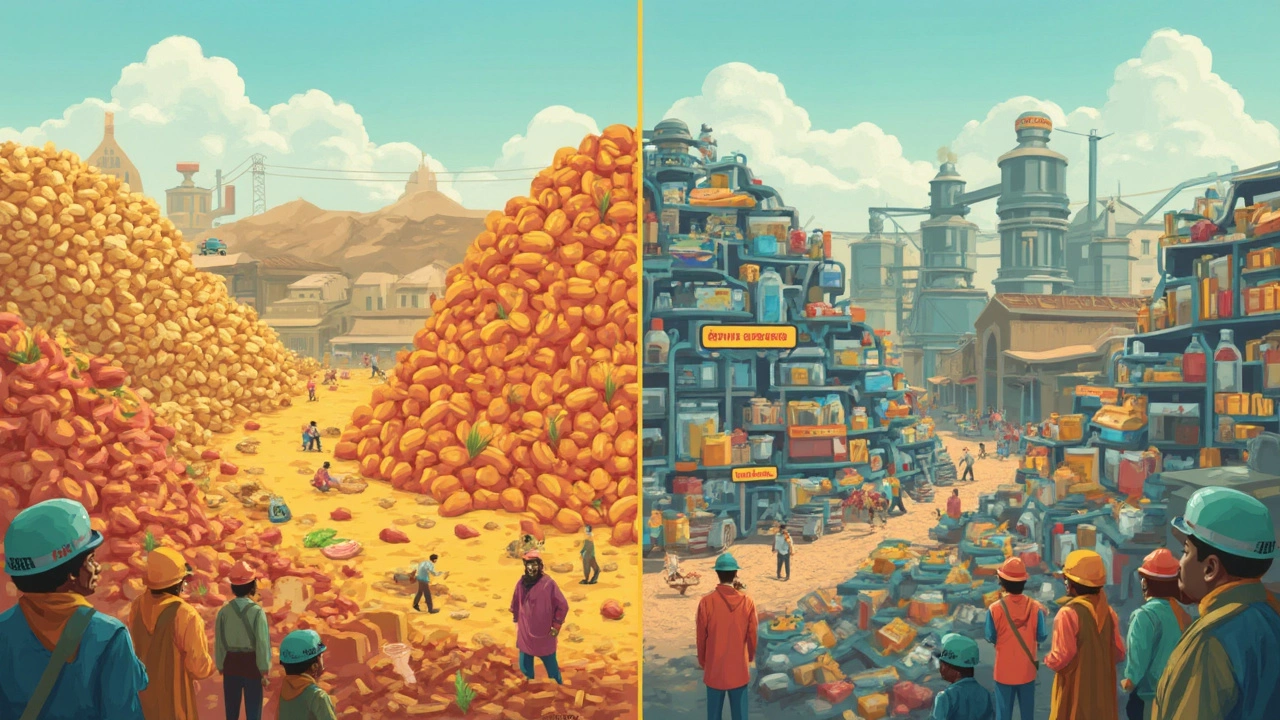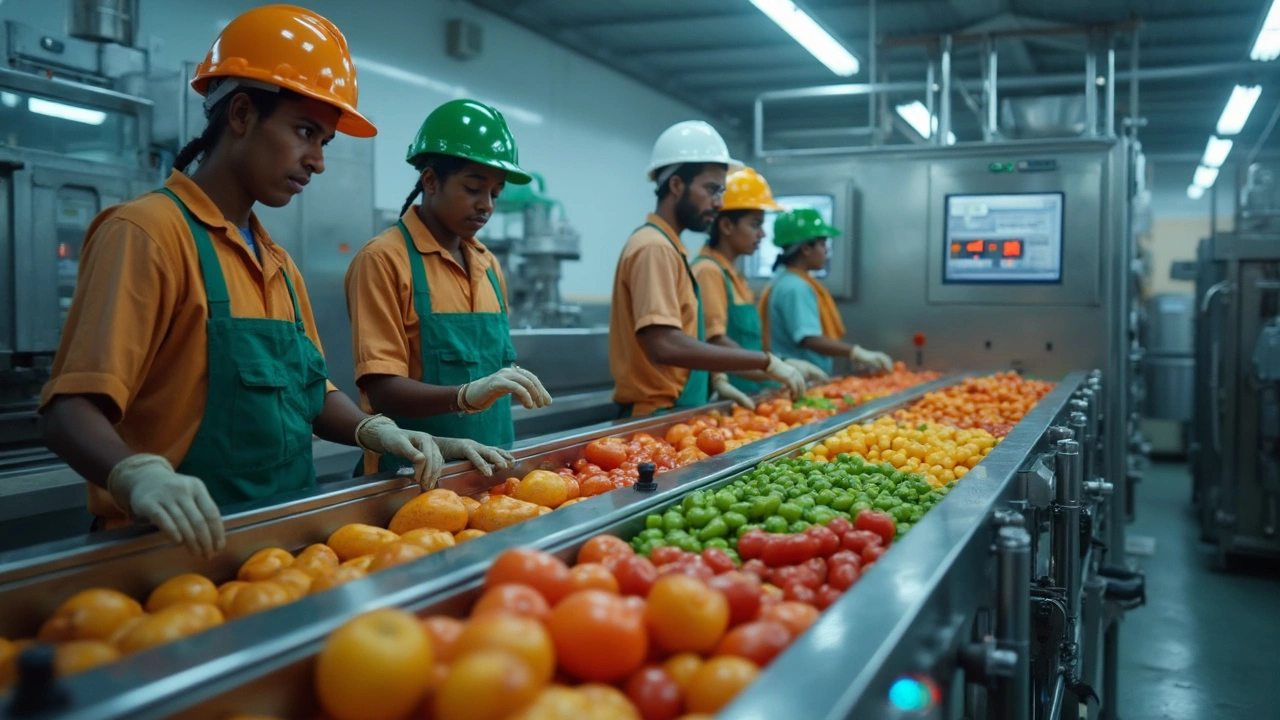Ever wondered what stands between a crop harvested from a farm and the breakfast cereal you pour into your bowl, or how juicy tomatoes become tangy ketchup? There’s a fascinating middleman in this story: the food processing unit. It’s a place where raw ingredients transform into the foods we see on supermarket shelves every day. People rarely stop to think about how biscuits, cheese, frozen veggies, or jams come to be so uniform and safe to eat—and that’s where food processing units shine, quietly, in the background of every meal.
What Exactly Is a Food Processing Unit?
Picture a bustling factory floor, stainless steel everywhere, flashing lights, and rhythmic whirls of machines—this is the world inside a food processing unit. At its core, a food processing unit is a facility fitted with equipment and technology to convert raw produce—like grains, fruit, meat, or milk—into products ready for the table, whether that’s fresh, packaged, canned, or frozen food.
The process is far more complex than just chopping things up and putting them in pretty boxes. Each food needs different equipment, temperatures, and timing. For example, to make cheese, a unit might have pasteurizers, fermenters, and chillers all working in sync. Potato chips, on the other hand, flow through washers, slicers, fryers, and packagers. There are stages like cleaning, sorting, blending, cooking, drying, and packaging, all organized for safety and efficiency.
These units follow strict hygiene rules. The last thing anyone wants is contaminated food ending up in their shopping trolley. Australian food safety standards, for example, require constant monitoring of temperature and equipment. Fun fact: Australia’s food processing industry is the largest manufacturing sector in the country, pumping out over $100 billion annually and employing around 230,000 people. The complexity and size of a unit can vary wildly. Some are small, focusing on a single line like locally made jams. Others are giants: Nestlé, Kellogg’s, and Heinz all have massive units handling thousands of tonnes of food each week.
Most people never get to walk inside one of these places unless they work there. The experience is part science lab, part high-tech kitchen. You’d see conveyor belts, sensors, temperature controls, and even robots doing repetitive tasks—packing biscuits or stacking bread loaves, for instance. Modern units lean hard into automation to boost speed and cut down on human error or contact. Want an idea of scale? The world’s biggest milk processing plant in the USA can handle 19 million litres of milk daily—imagine the cows needed for that!
So when you pick up a can of tomatoes or a packet of chips in Brisbane, there’s a whole hidden world of machines and people working together behind it, making sure each product is safe, tasty, and ready. It’s not just about convenience; it’s about making sure food gets from field to plate as efficiently and safely as possible, regardless of the season or the weather.
Types of Food Processing Units and Their Technologies
Not all food processing units are built the same—in fact, their designs and machinery depend heavily on what’s getting made. There are bakeries where flour turns into loaves and pastries, dairy units for milk, cheese, and yoghurt, meat plants for sausages and cuts, and large fruit-and-veg factories turning produce into preserved or frozen goods. Each type of unit has unique machinery, processes, and technology handling specific products.
Diving into specifics: Canning enterprises rely on sterilizers and vacuum sealers, keeping bacteria out for long shelf life. Frozen food factories have industrial freezers reaching –40°C, locking in freshness. Snack-food plants use rapid fryers and special tumblers to season chips and nuts, sometimes processing up to 3,000 kg an hour. The tech isn’t just about getting things cooked or cleaned; there’s a whole science around texture, taste, and appearance—ever noticed how your favorite cereal stays crunchy in milk? That’s the magic of controlled drying and toasting machinery.
Modern facilities use automation and AI to optimize everything, from sorting vegetables by size to tracking ingredient batches for recalls. Sensors embedded in machinery watch for temperature spikes or lost batches instantly. These tools cut waste and improve food safety. In fact, using optical sorting cameras has reduced errors and food loss by up to 10% in some Australian veggie factories.
The diversity is huge. Then there’s the micro side—artisanal and craft food processors, which Australia has in spades. Take local cheese makers in Queensland: they use small pasteurizers and open vats but still follow tight production controls, just on a friendlier scale than the monster plants. Even breweries, chocolatiers, and honey producers count as food processing units—they just operate with different kit and niche audiences. Chances are, every processed food you know comes from a specific type of processing unit tailored for that product.
Do these high-tech units smack of science fiction? Hardly. They’re way more common than you’d think. Step into any major supermarket, and at least half the products on a typical shopping list spent time inside a processing unit. It’s a balance of tradition, technology, and relentless tweaking. From the farmers growing wheat for bread, to the tech wizards programming automatic slicers, the whole system is designed to make good, safe food for everyone.
| Type | Main Products | Key Technology |
|---|---|---|
| Bakery | Bread, pastries | Ovens, mixers, proofers |
| Dairy | Milk, cheese, yoghurt | Pasteurizers, separators |
| Meat | Sausage, deli meats | Grinders, fillers, smokers |
| Canning | Veggies, beans, fruit | Sterilizers, sealers |
| Frozen food | Mixed veggies, meals | Blast freezers, packagers |

Why Food Processing Units Matter: Benefits and Controversies
Beneath all the shiny machines and conveyor belts, food processing units spark plenty of debate. On one hand, they offer huge benefits. Processed food often gets a bad rap, but the reality is that food processing units keep food safe, affordable, and available year-round. Remember when salads were just for summer? Thanks to fast freezing in processing units, we now eat fresh peas, berries, or mangoes whenever we want. The shelf life of packaged bread, for instance, is nearly triple that of fresh-baked loaves from a home oven. And when disaster strikes—floods, droughts, or pandemics—processing units cushion the shock by using stored, processed food ingredients.
Then there’s food safety. Sterilization, pasteurization, and sealed packaging reduce bacteria, mould, and spoilage bugs. The infamous 2008 listeria outbreak in Canada, for example, led to new safety standards now present in processing units worldwide, with more rigorous checks and automated tracking for every batch leaving the door. Without these precautions, packaged foods could be a wild gamble.
Food processing units also boost economies, especially here in Australia. By 2024 data, food and beverage processing made up around 27% of total manufacturing activity in the country. That equals jobs—not just inside the factories but for farmers, engineers, drivers, and marketers. It’s a whole chain effect: the wheat grown near Toowoomba, the nuts from Victoria, the milk from Gippsland. The unit is the meeting place for these raw goods, turning them into something you’ll put in your trolley or lunchbox.
But, sure, some controversy sticks. Not all additives are created equal, and “ultra-processed” foods—think sugary sodas, instant noodles, or packaged cupcakes—get linked to concerns about obesity, diabetes, and heart disease. Some folks argue food from a processing unit loses nutritional punch versus fresh, whole foods. Research out of Sydney in 2023 suggested Aussies get up to 40% of their daily calories from highly processed stuff. That’s leading manufacturers to rethink old recipes, focusing on less sugar and salt, more protein, and simpler ingredients. If you check the back of packets now, you’ll see words like “natural flavors” or “no preservatives” a whole lot more than five years ago.
Even sustainability is on the table. How much water, power, and packaging do these plants use? Some units are investing in solar panels and bio-gas powered machinery to reduce their footprint. In Queensland, for example, a major tomato processor cut annual water use by 11% after installing closed-loop systems. Every time you choose locally-processed food, it often means lower food miles and a fresher product.
There’s a weird kind of balance here. Food processing units can’t please everyone, but without them, our diets (and pantries) would look a lot more boring—and possibly a lot less safe. Next time you see a sliced loaf, snap-frozen veggies or a tub of Aussie yoghurt, just know there’s a story of investment, regulation, and clever tech behind every bite.
Tips for Understanding and Choosing Processed Foods Wisely
So, what does all this mean for people shopping at Woolies or Coles? Knowing how food processing units work helps you make smarter choices. First up, not all processed foods are the same. There’s a world of difference between a plain tin of beans and a box of neon-orange cheese puffs. The key is reading labels, checking for the least amount of added sugar, salt, or saturated fat, and picking options that are closer to their natural state.
- Look for short ingredient lists— the best products from food processing units don’t hide behind mysterious E numbers or artificial colors.
- Watch serving sizes. It’s easy to demolish three or four servings of certain processed snacks out of habit.
- Pick products processed for safety or preservation, not just flavour—think UHT milk, frozen peas, or tinned tuna.
- Shop local when you can. Australian-processed foods support local jobs and are often fresher on the shelf.
- Don’t shy away from the freezer aisle. Frozen veggies often retain more nutrients than “fresh” veggies that spent a week in trucks and warehouses.
All the big food brands now publish details about how their units handle ingredients. You’ll find QR codes on packs leading to videos or real-time traceability logs. Play private detective: check how your go-to products are made, and which units in Australia or overseas handle them.
People sometimes think “processed” is automatically bad, but that’s not always true. Milling wheat into flour, fermenting yoghurt, or pasteurizing drinks—these are all basic processing steps with a long, safe history. The real trick is to stay curious. Ask where your food comes from, which food processing unit made it, and how it got to your plate. Knowledge is power—not just for nutrition, but for making sense of all those choices staring back at you in every aisle.
Food processing unit is more than just a technical term in the food industry—it shapes nearly every meal and snack you eat, even when you’ve never seen the machines at work. So next time you crack open a can or unwrap a block of cheese, spare a thought for the science, skill, and technology humming away behind the scenes, all making sure your food is safe, tasty, and ready when you need it most.
